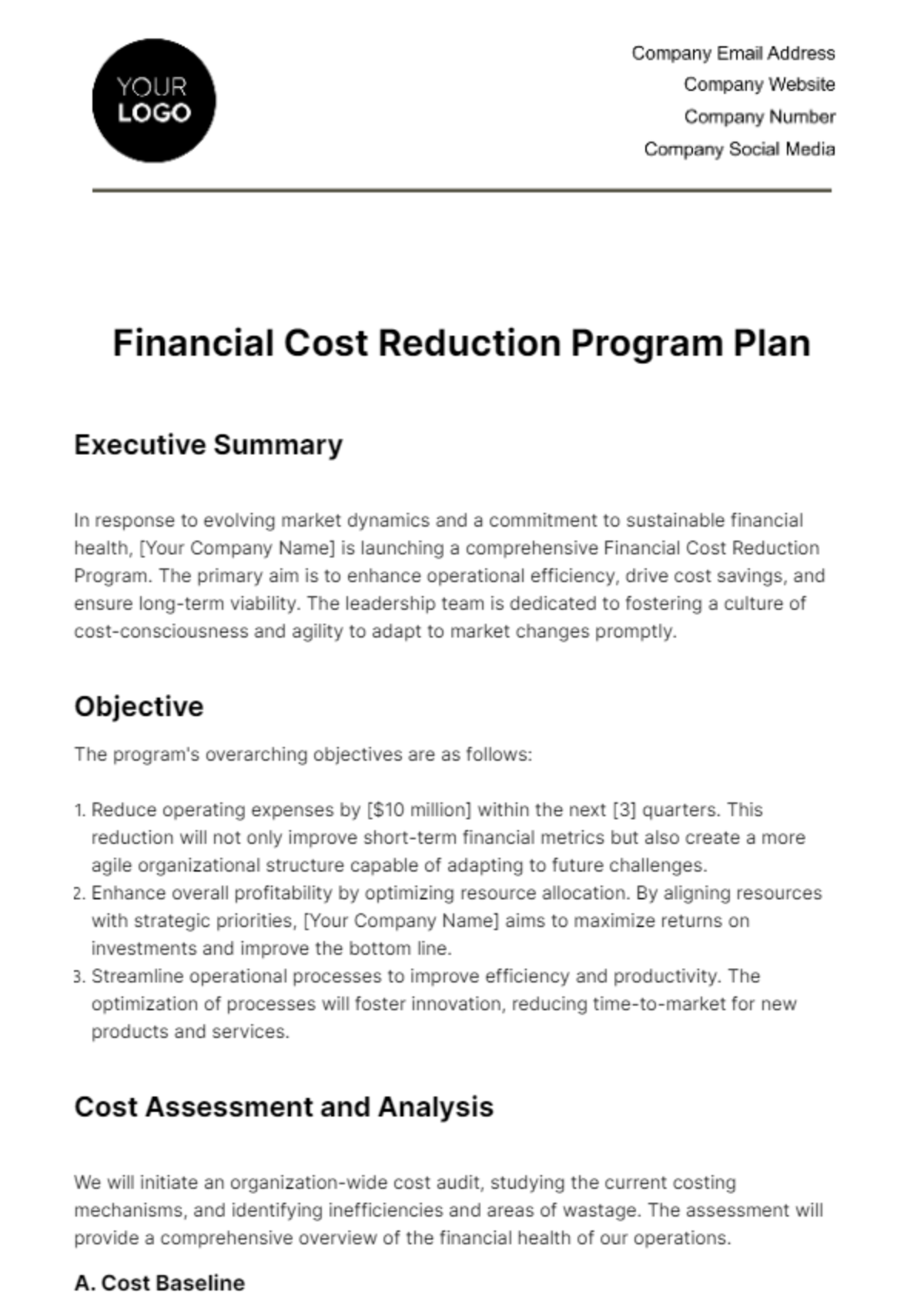Financial Cost Reduction Program Plan
Executive Summary
In response to evolving market dynamics and a commitment to sustainable financial health, [Your Company Name] is launching a comprehensive Financial Cost Reduction Program. The primary aim is to enhance operational efficiency, drive cost savings, and ensure long-term viability. The leadership team is dedicated to fostering a culture of cost-consciousness and agility to adapt to market changes promptly.
Objective
The program's overarching objectives are as follows:
Reduce operating expenses by [$10 million] within the next [3] quarters. This reduction will not only improve short-term financial metrics but also create a more agile organizational structure capable of adapting to future challenges.
Enhance overall profitability by optimizing resource allocation. By aligning resources with strategic priorities, [Your Company Name] aims to maximize returns on investments and improve the bottom line.
Streamline operational processes to improve efficiency and productivity. The optimization of processes will foster innovation, reducing time-to-market for new products and services.
Cost Assessment and Analysis
We will initiate an organization-wide cost audit, studying the current costing mechanisms, and identifying inefficiencies and areas of wastage. The assessment will provide a comprehensive overview of the financial health of our operations.
A. Cost Baseline
Current expenses across departments are as follows:
Department | Current Expenses |
|---|
Operations | [$25 million] |
| |
B. Cost Reduction Strategies
To achieve our objectives, the following strategies will be implemented:
Operations: Implementing lean practices and optimizing supply chain logistics. By streamlining operations, [Your Company Name] will not only reduce costs but also improve overall service delivery to customers.
Marketing: Focusing on high-impact, cost-effective digital marketing campaigns. The shift towards digital channels aims to reach a wider audience at a lower cost per acquisition, ensuring a better return on marketing investments.
R&D: Prioritizing projects with the potential for quicker returns on investment. By aligning research and development efforts with market demands, [Your Company Name] seeks to accelerate product development cycles and improve time-to-market.
Implementation Plan
A. Timeline
The program will unfold in phases over [12] months:
Phase | Duration | Responsible Party |
|---|
Planning | [3 weeks] | [Your Name] |
| | |
The phased approach allows for a systematic and well-coordinated execution, minimizing disruptions to ongoing operations and ensuring a smooth transition to the optimized processes.
B. Budget Allocation
The budget allocated for implementing the cost reduction strategies is [$50 million], distributed across various initiatives and departments. This budget allocation reflects a strategic balance between immediate cost savings and long-term investments in process improvements.
Monitoring and Evaluation
A. Key Performance Indicators (KPIs)
To track progress, the following KPIs will be monitored:
Percentage reduction in operating expenses: Target [15%]. Continuous monitoring of this KPI will provide insights into the effectiveness of cost reduction strategies and inform adjustments as needed.
Return on Investment (ROI) for implemented strategies: Target [20%]. Measuring the ROI will ensure that cost reduction efforts translate into tangible financial benefits for [Your Company Name].
Employee productivity improvement: Target [10%]. Improving employee productivity is a crucial element, ensuring that cost reduction efforts do not compromise the overall efficiency of the workforce.
B. Reporting Mechanism
Monthly progress reports will be generated and distributed to department heads and executives, highlighting key metrics, achievements, and areas for improvement. These reports will serve as a transparent communication tool, fostering accountability and collective responsibility.
Waste Reduction
Adopting environment-friendly practices like recycling and optimal utilization of resources will reduce waste and save cost in the long run. Implementing policies like 'Zero waste to landfill' will enhance our corporate social responsibility standing as well.
Risk Management
A. Identified Risks
Potential risks include employee resistance, supplier-related issues, and unforeseen market fluctuations. Acknowledging these risks proactively positions [Your Company Name] to develop robust mitigation strategies.
B. Mitigation Strategies
Mitigation strategies include change management programs, diversified supplier partnerships, and scenario planning for market uncertainties. By having proactive mitigation plans in place, [Your Company Name] can navigate challenges and maintain the momentum of the cost reduction program.
Communication Plan
A. Internal Communication
Internal communication will be facilitated through regular team meetings, newsletters, and an intranet platform. Ensuring open and transparent communication will create a sense of shared purpose and commitment among employees.
B. External Communication
External stakeholders will be informed through press releases, updates on the company website, and communication through official social media channels. Clear and consistent external communication will maintain [Your Company Name]'s reputation and assure stakeholders of the organization's commitment to sustainable growth.
Continuous Improvement
Cultivating an organizational culture of continuous improvement is vital. Streamlining processes, uncovering and eliminating hidden costs, leveraging technological advancements, and always seeking ways to do better should be ingrained among all employees.
Created by: [YOUR NAME]
Finance Templates @ Template.net






























